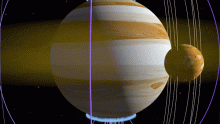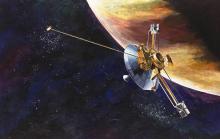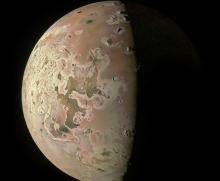Listen to today's episode of StarDate on the web the same day it airs in high-quality streaming audio without any extra ads or announcements. Choose a $8 one-month pass, or listen every day for a year for just $30.
You are here
Moon and Jupiter
Earth isn’t the only world in the solar system that’s wet. Jupiter and some of its big moons are awash in water. In fact, several of the moons have hidden oceans. And each of those oceans has more water than all the oceans on Earth combined.
A recent study found that there’s quite a lot of water at Jupiter as well. The planet doesn’t have a solid surface, so it doesn’t have oceans. But there’s a fair amount of water vapor in the atmosphere. Some of it condenses to form clouds. The clouds produce rainfall, as well as giant blasts of lightning.
The moons Europa, Ganymede, and Callisto appear to have oceans below their icy crusts. Europa is the most intriguing of the moons because its crust is fairly thin – in some places, as little as a mile or two. There’s evidence that water occasionally squirts through cracks in the crust to reach the surface. There’s no atmosphere to speak of, though, so the water either freezes onto the surface or vaporizes into space.
Jupiter and its moons follow our moon across the sky tonight. Jupiter looks like a brilliant star. It’s to the left of the Moon as they climb into good view around midnight. It’s to the upper left of the Moon at first light tomorrow. The planet’s four largest moons, including the watery ones, are visible through binoculars. They look like tiny stars close to the giant planet.
As a bonus, the planet Saturn is close to the upper left of Jupiter. We’ll have more about that tomorrow.
Script by Damond Benningfield






